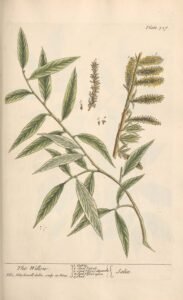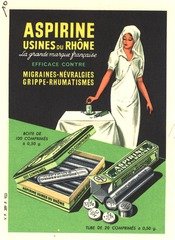July Book Review
Managing Pain: The History of Aspirin
By Adriana Suarez
This blog post provides information about objects on display in the Grossmont Healthcare District’s Health & Wellness Library.
For centuries, it seems that humans have tried anything and everything in the name of pain relief. Pre-Inca cultures used coca plant leaves to relieve pain,n while the Romans and Greeks used alcohol, opium, and mandrake root as painkillers. Electric fishes were used by the Egyptians, Romans, and Greeks to shock away headaches, arthritis, and other pains. While in the Middle Ages, people would soak sea sponges in brews of wine, plants, and herbs, and place them in their nose and mouth for pain relief.

Now, advances in medicine have made managing pain much easier and practices involving sea sponges, electric fish, and plants are no longer necessary. But as unconventional or bizarre as some of these past practices may seem, they should not be completely dismissed as antiquated. According to the World Health Organization, close to 40% of pharmaceutical products available today are drawn from nature and “traditional knowledge”. It should be noted that plants have long been used in medicine, since before humans even began writing, making nature the original medicine. As a result of these practices, many plants were found to have health benefits, some of which are responsible for modern medicines. In fact, about 11% of essential drugs today originate from flowering plants, including aspirin. Who would’ve thought that a plant would eventually become the foundation of one of the most commonly used drugs in the world?
Aspirin has roots that go as far back as to ancient Egypt and Sumer. While aspirin is not naturally found, it is created using salicylic acid, an organic compound that was originally found in willow bark. The Ebers papyrus, one of the oldest medical works known, refers to Egyptian medicines made with willow bark. Unfortunately, the document does not clearly reveal what health purpose the willow bark served or was meant to serve. While some reports claim that willow bark was used as a painkiller by the Egyptians and Sumerians, others say that there is no evidence to support this claim. However, what ancient texts do prove is that willow bark was utilized by these ancient civilizations in their health practices.
Other ancient medical uses of willow bark include the Romans, who used it as treatment for uterine prolapse; however, it is unclear if the bark was meant to treat the pain or had another treatment purpose. There are also some reports of Hippocrates administering a willow type of tea to women in labor and those suffering from fevers in Ancient Greece. Additionally, it is believed that both the Ancient Greeks and Romans used willow bark to treat colic, gout, ear pain, and other body pains.

The foundation for the creation of modern-day aspirin happened in the 18th century, when in 1763, Edward Stone, an English Reverend, experimented with willow bark after feeling ill. Stone, while out on a walk, came upon a willow tree and was compelled to take a bite of the bark. Upon tasting the bark, he found that the taste resembled that of a Peruvian tree that was known to contain quinine, a medicine used to treat malaria. Due to the similar taste, Stone speculated that willow bark could be used for medicinal purposes, specifically to relieve symptoms of malaria and other fevers. He then began to experiment with the bark by collecting it, drying it for over three months, and pounding it to create a powder. After testing it on himself, he administered it to 50 people who had been suffering from fevers. His results were mostly successful. However, when the bark did not successfully respond to patients, he added quinine to his mixture, which then proved to be more effective. Stone reported his findings to the Royal Society of London, and as a result, willow bark was advised for health practices. Ultimately, his work led him to inadvertently discover a source of salicylate, an important compound that is used in the formation of aspirin.

However, the aspirin we all know and use today would not actually be produced until the 19th century. In 1838, an Italian chemist named Raffaele Piria produced a highly potent acid form of willow extract, which he named salicylic acid. His work eventually led chemists Felix Hoffman and Arthur Eichengrün to create acetylsalicylic acid, or aspirin. In 1897, under the German pharmaceutical company, Friedrich Bayer & Co., Hoffman and Eichengrün experimented with salicylic acid to develop aspirin in powder form. At the time, Bayer was looking to expand their business and established a drug research program with the purpose of creating new drugs; it is safe to say they accomplished their goal with the creation of aspirin. In 1899, after promising test results, aspirin was on the market and selling globally.
Unfortunately, the company’s development of the drug has some contentions as to who receives the credit for it. While Bayer credits Hoffman for the development of aspirin, some reports state otherwise. Wherever the credit lies, the impact of nature and ancient practices cannot be denied in the production of aspirin. Today, it is used to treat pain, fever, and arthritis. It has also been shown to improve blood pressure and lower the risk of heart attack, stroke, and blood clots.
If you are interested in learning about medical history, come visit the Library and view our display on modern surgery, which includes a section on pain management. The Library also has several titles on pain management and the history of medicine that are available for you to check out.
Titles include:
- An Anatomy of Pain: How the Body and the Mind Experience and Endure Physical Suffering by Dr. Abdul-Ghaaliq Lalkhen
- The Pain Management Workbook: Powerful CBT and Mindfulness Skills to Take Control of Pain and Reclaim Your Life by Rachel Zoffness
- Empire of the Scalpel: The History of Surgery by Ira Rutkow
- History of Medicine: A Scandalously Short Introduction by Jacalyn Duffin
- Medical Firsts: Innovations and Milestones That Changed the World by Tish Davidson

